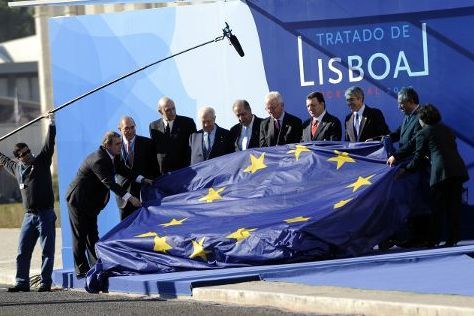EU countries sign new core agreement
In the capital of Portugal, Lisbon, the leaders of the European Union solemnly signed an agreement on the reform of European political institutions, called the Lisbon Accords. The document became a simplified version of the EU constitution, the preparation of which was carried out from the mid 90-ies of the last century.
According to the new agreement, it is planned to introduce the post of EU President, who will be elected for a term of 2.5 years. At the same time, analysts call Tony Blair, the main contender for the post of the first president of the EU, the former British Prime Minister.
In addition, the treaty provides for the reform of the EU executive body, the European Commission, into which a European Commissioner for Foreign Policy, who will have broad powers, will be introduced, who will report to EU leaders.
The agreement also establishes that the European Commission should undergo a reduction in composition – from the current 27 European Commissioners to 17 by 2014. Moreover, the composition of the EC will be elected for a term of 5 years.
The powers of the European Parliament will also be expanded, which will gain more influence on legislative initiatives, especially in the field of justice and internal affairs. The number of European parliamentarians will also be reduced – from 785 to 751 deputies.
The new treaty should replace the draft of a unified European constitution, the ratification process of which was interrupted after the failure of referenda in France and the Netherlands. However, for this a new treaty must be ratified in all 27 countries participating in the bloc.
The ratification of the new treaty should be completed by June 2009, when the elections to the European Parliament will take place. Most countries (with the exception of Ireland) will ratify the Lisbon Accords through a parliamentary vote.
Germany, France and Poland declare their readiness to ratify the agreement immediately in order to implement the reforms as early as 2009. However, opponents of the new document say that the introduction of the presidency and the head of the general foreign affairs agency will only intensify competition between members of the alliance for control over these important areas.
Note that the European Union for almost a decade has been trying to develop a program for reforming its core institutions. The need for a new regulatory document is associated with an almost twofold increase in the bloc (from 15 states to 27), as well as the emergence of new tasks in the field of foreign policy, energy and the environment.
Lisbon Signs New EU Principles
The signing ceremony of the “Reform Treaty”, a new basic document defining the principles for the functioning of the European Union, took place on Thursday at the Monastery of the Order of St. Jerome in Lisbon.
The signature of the treaty, which was officially named Lisbon, and was approved in October this year, was put by the heads of state and government of 27 EU member states.
The first contract signed by the Prime Minister and Foreign Minister of Belgium Guy Verhofstadt and Karel de Gucht.
The ceremony was not attended only by British Prime Minister Gordon Brown. Due to an important session in parliament, he was forced to skip it, join the EU leaders at lunch and sign the agreement later.
The signing process, which the Belgian newspaper Suar called the “protocol show,” was broadcast live at the European Commission’s press center in Brussels.
The Lisbon Treaty is expected to enter into force in early 2009 after its ratification by all EU countries. With the exception of Ireland, which intends to hold a referendum, all EU members will limit themselves to ratification of the treaty by national parliaments.
The new EU core treaty replaced the draft European Constitution, which it was decided to refuse to ratify after it was rejected by the majority of the French and Dutch during the 2005 national referenda.
The Lisbon Treaty simultaneously incorporated the amended and revised provisions of previously concluded agreements on the principles of the life of a united Europe – the Treaty of Rome (1957), Maastricht (1992), Amsterdam (1996) and the Treaty of Nice (2000), during which the institutional The crisis was based on the functioning of EU institutions.
Unlike the draft EU Constitution, the “Reform Treaty” does not mention the constitutional symbols of the European Union – the flag, anthem and single currency. At the same time, it provides for the introduction of the post of President of the European Council, which will be elected for two and a half years, and to represent the organization at the international level.
The High Representative for the Common Foreign and Security Policy, according to the agreement, will have the actual powers of the EU Foreign Minister. He is elevated to the rank of Deputy Chairman of the European Commission, and the functions of the European Commissioner for General Foreign Policy and European Neighborhood Policy are transferred to him.
The executive branch of the EU will also undergo changes. Since 2014, the number of European Commissioners will be equivalent to two-thirds of the EU member states. Today, each of the 27 states is represented by a member of the European Commission.
The treaty enhances the role of the European Parliament. According to the document, deputies, along with EU countries, will have the right to approve legislation in a number of “sensitive areas”, such as justice, security and immigration policy.
However, the total number of seats in the European Parliament is reduced from the current 785 to 750. In addition, for the first time, national parliaments will be granted the right to participate in legislative activities of the EU.
They, in particular, will have the right to submit their proposals to the text of bills. If one third of the national assemblies is opposed, the draft law will be sent for revision to the European Commission, which was initially entrusted with the task of developing draft legislative acts.
The areas of decision-making in the Council of the EU by the formula of a qualified majority vote, and not by consensus, have been extended to the jurisdiction of the judiciary and the police. The agreement also introduces a new voting system according to the so-called “double majority” formula.
The new system will begin to operate in 2014 with the transition period agreed by Poland until 2017. According to the principle of “double majority”, a decision is considered adopted if representatives of 55% of the EU states, in which at least 65% of the population of the European Union live, vote for it. However, countries that fail to create a blocking minority will be able to postpone the resolution of the issue and offer to continue negotiations.
In addition, the new basic treaty on the functioning of the EU provides for the implementation of a common energy policy and the implementation of a common strategy to combat global warming, providing joint assistance to one or more members in case of terrorist attacks or natural disasters.
In addition, the document contains an article on the possibility of secession from the EU, a decision on which will be made following the results of general negotiations.
This post is also available in:
 English
English  Русский (Russian)
Русский (Russian)





